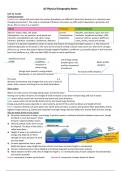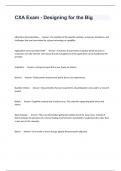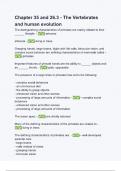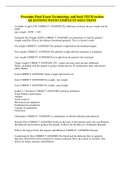A2 Physical Geography Notes
Unit 1a: Coasts
Coastal processes
Coastal zone- where the land meets the sea but boundaries are di cult to determine because it is a dynamic ever-
changing environment. The coast is composed of features of erosion e.g cli s and/or deposi on e.g beaches and
dunes. We can view it as a sysytem.
Inputs Processes Outputs (features)
Marine- waves, des, salt spray Erosion Beaches, sand dunes, spits, bars and
Atmosphere- sun, air pressure, wind speed and Transporta on tombolos, headlands and bays, cli s,
direc on, precipita on (rain, hail, sleet, snow) Deposi on wavecut notches, wavecut pla orms,
Humans- pollu on, recrea on, se lement, defences caves, arches, stacks and stumps.
A system is in dynamic equilibrium when its inputs and outputs of energy and ma er balance. I.e. the amount of
sediment deposited on the beach is the same as the amount eroded so beach stays same size. Short term changes
s ll occur e.g. storms but system adjusts through nega ve feedback. Landforms e.g. beaches adjust in few hours but
hard rock landforms e.g. cli s may take 1000s of years to reach equilibrium.
Equilibrium beach An cyclonic Low energy saving
pro le condi ons- breakers give a net Beach pro le
reduc on in onshore movement steepens
wave energy of sediment
Energy input (swash)= energy output As beach pro le steepens,
(backwash): no net sediment transport
The coast is a
dynamic environment and changes that occur are a result of
waves, des, seasons and long term sea level uctua ons
Wave ac on
Waves are main source of energy along coasts, formed by wind
moving over surface of water. As strength of wind increases so too does fric onal drag and size of waves.
Sea- waves which result from local winds and travel only short distances
Swell- waves which are formed by distant storms and travel large distances
Energy acquired by waves depends on: wind velocity, period of me wind has blown and length of fetch
Fetch- maximum distance of open water over which wind can blow, so places with greatest fetch poten ally receive
highest energy waves e.g. Galway has long fetch and high energy whereas Belfast has shorter fetch and less energy.
Why do waves break on the shore?
❖ No actual movement of water: just energy. A par cle moves in clockwise direc on between wave crest, trough
and back to crest but doesn’t move
forward- called oscilla on waves.
❖ Orbit of par cle varies from circular
to ellip cal. The base of the orbit is
called wave base.
❖ Height of wave is an indica on of
energy and depends on fetch,
strength of wind, dura on of wind
and sea depth.
❖ As wave approaches shore, water
depth decreases, wave length becomes shorter and wave increases height to compensate
❖ Circular mo on becomes more ellip cal as fric onal drag with sea bed decreases velocity.
❖ Wave steepens further un l ra o of height to length is 1:7. Eventually body of wave collapses forward (breaks)
and rushes up beach.
Swash- movement of water up the beach Backwash- movement of water down the beach
,Seabed topography (shape) can in uence how wave breaks: steeper shingle pro le will produce taller, steeper wave
more likely to plunge. Gently shelving sea bed with long run up encourages lower-pro le waves.
Construc ve waves- at waves with long wavelength and low height, carrying sediment up the beach with a strong
swash
• Long wave length
• 6/8-10/ minute
• Low in height
• Strong swash- builds up the beach
• Weak backwash
• Lower energy waves
Destruc ve waves- steep/ plunging waves that occur in high energy
loca ons, eroding sediment through a strong backwash
• Short wave length
• 11-15/ minute
• High in height- steep
• Weak swash
• Strong backwash- erosion of sediment
• Higher energy waves
• Found where there is a steep shelving sea bed
In uence of waves and sediment of beach morphology (shape/
pro le of beach)
Beach morphology is dependant on: wave type, energy, sediment
and sea bed morphology. (Complex rela onship)
➢ Sand forms wide, gentle gradient beaches, whereas shingle
forms narrow steeper beaches due to larger par cle size.
Cobbles (shingle) was diameter 32mm crea ng beach angle 24
whereas medium sand has diameter 0.2mm crea ng beach
angle 5.
➢ Construc ve waves have stringer swash and weaker backwash,
carrying material up beach but not enough energy to carry it
back down (deposi on)
➢ Destruc ve waves have weak swash, small swash distance and strong high energy backwash, draws materials
back down beach (erosion)
➢ On shingle beach, swash is stronger and backwash weaker due to high percola on rates. Sediment is moved up
beach as high percola on means backwash too weak to remove sediment.
➢ Sandy beaches have strong swash with long run up due to at pro le and similar strength backwash due to low
percola on rates on compressed sand (material combed back down beach but returned in next wave)
➢ Finer sediments don’t require as much energy to be eroded and transported. Higher energy environments have
coarser sediment sizes.
➢ Most changes occur within sweep zone between high and low de. Above high de mark a storm becah (berm)
may form when material is ung to top of beach. (storm condi ons)
Most Bri sh beaches have both waves types during year, destruc ve waves domina ng in winter and construc ve
in summer. Explains why sandy beaches are eroded badly during winter when high energy destruc ve waves are
combined with gently sandy pro le. Percola on rate on backwash is low so material is dragged from beach. As
smaller par cle sizes don’t require much energy to be transported beaches depleted quickly. During stormy
condi ons sand and larger material is thrown up the beach crea ng storm beach of larger pebbles. During low-
energy condi ons with construc ve waves, sandy beach can be replenished by strong swash.
Wave refrac on- occurs where the undersea topography (pro le) causes the wave fronts to slow, bend and aim to
break parallel to shore. This e ect is most o en seen in a headland and bay coastline.
1. Where waves approach an irregular coastline, the are refracted (become increasingly parallel to coastline. This is
best illustrated where a headland is separated by 2 bays
, 2.As each wave crest nears coast, it tends
to drag in shallow water near a headland
or any shallow water, so por on of crest in
deeper water moves forward while that in
shallow water is retarded by fric onal drag
so that wave bends.
3.The orthoginals (lines at right angles to
wave crests) show stages in advance of
par cular wave crest
4.Wave energy becomes concentrated
upon and so accentuates erosion at
headland
5.Deposi on is more likely in sheltered
bay, forming a beach.
Tides- changes in water levels due to gravita onal a rac on exerted on oceans by moon and to lesser extent the sun.
Bri sh coastline has 2 high and 2 low des each day
Spring de- high de is higher than normal Neap de- high de is lower than normal (7/14 days a er spring de)
Tidal range- di erence between low and high de and controls ver cal distance over which waves and currents carry
out geomorphic work.
A small dal range = wave energy being concentrated across rela vely narrow zone with increased erosion poten al.
Deposi on outcomes include produc on of rela vely narrow beach e.g. Mediterranean Sea has small dal range and
many holiday resorts there have narrow beaches.
Tidal range around Bri sh Isles is variable reaching maximum in large estuaries e.g. over 6cm in Severn estuary
Storm surges- rapid rises in sea level where water is piled up against coastline far in excess of normal condi ons.
When they occur near densely populated areas pose major natural hazard as can cause loss of life, damage to
property and disrup on to everyday life.
Coastal erosional processes-
Marine- direct erosion by sea subaerial- erosion and weathering by wind, rain and frosts
Abrasion/corrasion- wearing away of cli s by sand, shingle and boulders hurled against them by waves. It is most
e ec ve method of erosion and most rapid on coasts exposed to storm waves.
A ri on- rocks and boulders already eroded from cli s are broken down into smaller and more rounded par cles
Hydraulic pressure-when a parcel of air is trapped and compressed either in joint in cli or between breaking wave
and cli , resultant increase in pressure may weaken and break o pieces of rock or damage sea defences
Corrosion/ solu on- includes dissolving of limestones by carbonic acid in sea water and evapora on of salts to
produce crystals which expand as they form, causing rock to disintegrate. Salt from sea water or spray can erode
several rock types. Bacteria can also cause this.
Wave pounding- when steep waves with considerable energy break as they hit foot of cli s or sea walls, may
generate shock waves up to 30 tonnes per sq m. Some sea walls in eastern England need replaced within 25 years
due to this
Sub-aerial- rain erodes cli s either by falling directly onto them or as result of through ow or surface runo from
land. This water along with e ects of weathering from wind and frost can lead to mass movement either as soil creep
on gentle slopes or slumping and landslides on steeper slopes.
Human ac vity- increase in pressure resul ng from building on cli tops and removal of beach material which may
have otherwise protected base of cli contribute to more rapid coastal erosion. Rates of erosion may be reduced
locally by construc on of sea defences so human ac vity has the e ect of disturbing equilibrium of coast system.
Factors a ec ng rate of erosion
Supply of beach material- although
Wave steepness- very steep destruc ve sea waves have
con nual supply is needed to erode
more energy and erosive power than gentle construc ve
cli s, a surfeit protects coast by
swell waves formed many km away
absorbing wave energy













